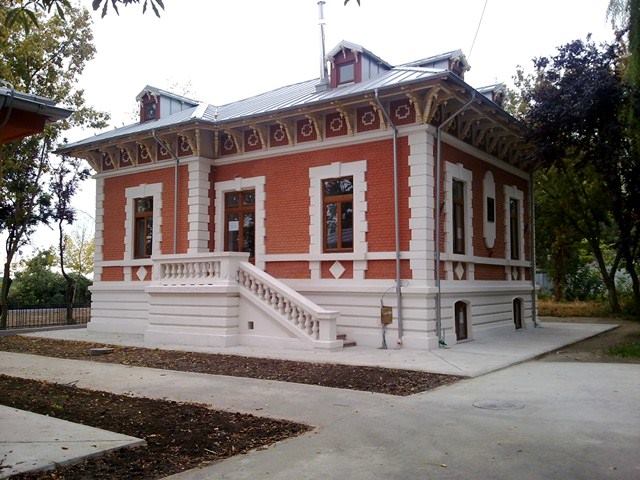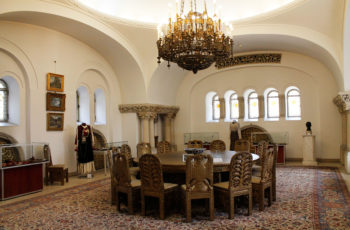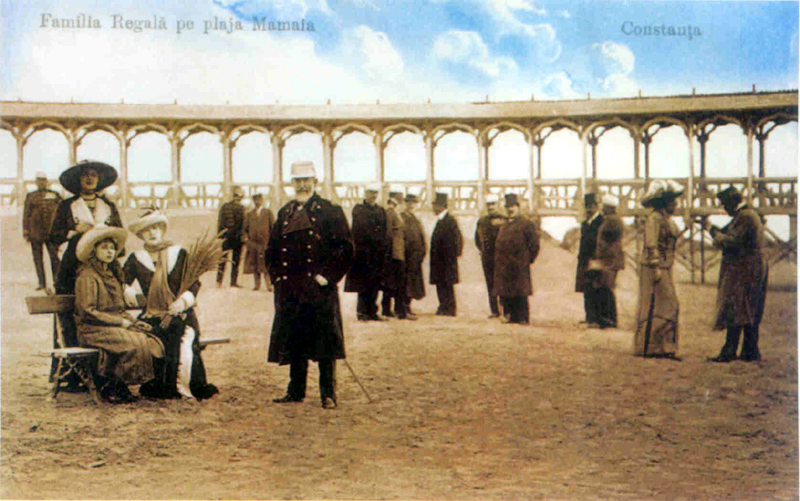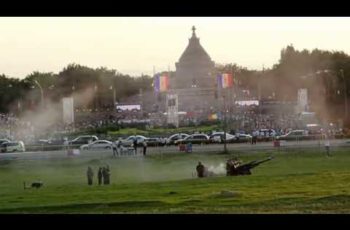Graziano Baccolini, precizează, în volumul “Reflections on the Etruscan Civilization”: “Îmi este greu să înţeleg de ce, încă, unii istorici italieni eşuează în a înţelege contribuţia enormă a civilizaţiei etrusce la clădirea culturii vestice şi de ce, continuând să se ghideze după dovezi false, afirmă că grecii şi romanii reprezintă culturile superioare primordiale ale Europei”.

Elementul cel mai important, între afirmaţiile acestui autor, este reprezentat de următoarele precizări: “Sunt sigur că etruscii au venit din estul Europei şi sunt adevăraţii fondatori ai culturii acestui continent. Deşi unii istorici italieni continuă să nege asta, cei mai mulţi istorici, la nivel mondial, sunt de acord cu această teorie.
ÎN ZORII DEZVOLTĂRI LOR MILITARE, ROMANII, CU O CULTURĂ INFERIOARĂ, ŞI-AU FALSIFICAT ORIGINILE ŞI AU ASCUNS MOŞTERNIREA CIVILIZAŢIEI ETRUSCE, IAR FALSIFICAREA ISTORIEI LOR A CONTINUAT, ÎN VREMEA PRIMILOR ÎMPĂRAŢI CREŞTINI, PRINTR-O SERIE DE EDICTE”.
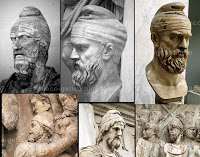 Originea etruscilor a stârnit controverse printre cercetători timp de mulţi ani. Dar opiniei că aceştia erau descedenţi ai unor neamuri tracice din Lydia şi Frigia îi subscrie chiar şi Massimo Pallatino, considerat “părintele etruscologiei”. Potrivit acestuia, etruscii care au dezvoltat cultura superioară a Italiei, în Cerveteri, Tarquinia, Vulci şi Vetulonia nu erau altceva decât urmaşi ai tracilor din Asia Mică, veniţi în Italia cu mult înaintea romanilor.
Originea etruscilor a stârnit controverse printre cercetători timp de mulţi ani. Dar opiniei că aceştia erau descedenţi ai unor neamuri tracice din Lydia şi Frigia îi subscrie chiar şi Massimo Pallatino, considerat “părintele etruscologiei”. Potrivit acestuia, etruscii care au dezvoltat cultura superioară a Italiei, în Cerveteri, Tarquinia, Vulci şi Vetulonia nu erau altceva decât urmaşi ai tracilor din Asia Mică, veniţi în Italia cu mult înaintea romanilor.
Totuşi, în ciuda falsificării parţiale a istoriei pre-romane de către unii autori şi împăraţi romani, există şi surse latine care recunosc originea tracă a etruscilor. Vergilius notează:”Oraşul Cerveteri este construit pe o stâncă locuită cândva de lidieni, un popor distins în războaie, ce vieţuia pe toate dealurile Toscanei”. De asemenea, Seneca afirmă că “Asia Mică este locul unde au trăit etruscii la începuturi”.
 Un alt autor antic, Tacitus, confirmând unele informaţii transmise de Herodot, ne spune că: “Etruscii au venit din Asia Mică, ei fiind urmaşi ai pelasgilor, fiind numiţi thirasieni sau thiresieni în insulele Lemnos, Imbros şi Lesbos şi în Delos, insula sfântă a Cicladelor”.
Un alt autor antic, Tacitus, confirmând unele informaţii transmise de Herodot, ne spune că: “Etruscii au venit din Asia Mică, ei fiind urmaşi ai pelasgilor, fiind numiţi thirasieni sau thiresieni în insulele Lemnos, Imbros şi Lesbos şi în Delos, insula sfântă a Cicladelor”.
Enciclopedia Britannica: “Etruscii erau traci”
Revenind la sursele moderne care atestă descendenţa tracă a etruscilor, trebuie să amintim de o specificaţie din Enciclopedia Britannica, potrivit căreia “la începutul expansiunii lor, romanii au fost iniţial respinşi, în Toscana, de către etrusci, care au venit cu mult înaintea lor, din Anatolia, fiind descendenţi ai tribului trac al frigilor/brigilor.
În lucrarea “The Asiatic affinities of the old Italians”, aparţinând lui Robert Ellis, se precizează că neamurile tracilor se întindeau până la Alpi şi Marea Tireniana (a se observa asemănarea numelui acestei mari cu cel dat de greci etruscilor, respectiv thirasieni), limba acestora fiind vorbită şi în Etruria.
 Ellis mai opinează că: “TOŢI TRACII, INCLUZÂNDU-I PE ETRUSCI, DACI ŞI FRIGIENI, VORBESC ACEEAŞI LIMBĂ”. În lucrarea amintita mai sus se mai spune şi că proto-etruscii şi-au dezvoltat cultura, în perioada de trecere dintre epoca bronzului şi cea a fierului, în zona Anatoliei şi a Mării Negre, această cultură fiind “iluminatoarea Eurasiei”.
Ellis mai opinează că: “TOŢI TRACII, INCLUZÂNDU-I PE ETRUSCI, DACI ŞI FRIGIENI, VORBESC ACEEAŞI LIMBĂ”. În lucrarea amintita mai sus se mai spune şi că proto-etruscii şi-au dezvoltat cultura, în perioada de trecere dintre epoca bronzului şi cea a fierului, în zona Anatoliei şi a Mării Negre, această cultură fiind “iluminatoarea Eurasiei”.
Dacii şi etruscii – formatorii culturii europene?
Dovezile privind importanţa etruscilor şi traco-dacilor în istoria antică a Europei nu se opresc aici. Într-o altă lucrare, anume “The Hidden Roots of Europe”, editată de Fundaţia Culturala Animi, Muzeul Naţional Brukenthal şi Muzeul Civic Pitigliano, se arată că “la nivelul mileniului I î.e.n, populaţiile care locuiau teritoriile de astăzi ale României, Bulgarei şi Italiei, respectiv dacii, tracii şi etruscii, au creat culturi originale, care AU JUCAT UN ROL IMPORTANT ÎN FORMAREA ARTEI GRECO-ROMANE.”
Tot în acest volum se mai arată că teritoriile amintite au o moştenire istorică bogată, aici găsindu-se semnele celor mai vechi civilizaţii preistorice, dezvoltate la nivelul neoliticului, al epocii bronzului şi al celei de fier. Citând din lucrarea amintită, trebuie să mai spunem că: “deşi numiţi barbari de greci şi de romani, populaţiile despre care vorbim au creat culturi cu nimic inferioare celor greacă şi romană, ba chiar se poate spune că, de pildă, în ceea ce priveşte arhitectura şi arta, ETRUSCII, DACII ŞI TRACII I-AU INFLUENŢAT DECISIV PE GRECI ŞI ROMANI”.
Traco-etruscii şi relaţia cu grecii
 O serie de autori antici eleni din preajma secolului V î.e.n. ne-au transmis referiri clare asupra etruscilor şi rolului jucat de aceştia în dezvoltara civilizaţiei elene. Cei mai mulţi dintre ei stabilesc o conexiune clară între etrusci şi pelasgi. Hellanikos din Mytilene, de pildă, afirmă că fondatorii oraşelor Crotona şi Tyrrhenia din Italia erau etrusci plecaţi din Tesalia, Grecia, în timp ce Tucidite (în “History of the Peloponnesian War 4.109.4″), precizează că multe aşezări din Akte au fost înfiinţate de etruscii veniţi din Lemnos şi Atena. Acesta vorbeşte şi despre câteva neamuri ce formau poporul etrusc, respectiv bisaltienii, krestonienii şi edonienii, “care trăiau în mici oraşe”.
O serie de autori antici eleni din preajma secolului V î.e.n. ne-au transmis referiri clare asupra etruscilor şi rolului jucat de aceştia în dezvoltara civilizaţiei elene. Cei mai mulţi dintre ei stabilesc o conexiune clară între etrusci şi pelasgi. Hellanikos din Mytilene, de pildă, afirmă că fondatorii oraşelor Crotona şi Tyrrhenia din Italia erau etrusci plecaţi din Tesalia, Grecia, în timp ce Tucidite (în “History of the Peloponnesian War 4.109.4″), precizează că multe aşezări din Akte au fost înfiinţate de etruscii veniţi din Lemnos şi Atena. Acesta vorbeşte şi despre câteva neamuri ce formau poporul etrusc, respectiv bisaltienii, krestonienii şi edonienii, “care trăiau în mici oraşe”.
Şi Herodot vorbeşte despre faptul că Attica şi Atena au fost iniţial locuite de pelasgo-etrusci (Histories 6.137) şi că, “după ce au fost alungaţi de aici, s-au retras în Lemons, de unde mulţi veniseră”. De altfel, în 1885, pe o piatră descoperită în satul Kamina din Lemnos, a fost descoperită o inscripţie considerată ca fiind de origine etruscă. Despre gradul de evoluţie a etruscilor ne vorbeşte Herodot atunci când spune că “etruscii sunt primii oameni care au creat şi folosit monede din aur şi argint”.
Zonele Elladei locuite de etrusco-pelasgi sunt amintite şi de Homer (Iliada): Tesalia, Atica, Argolis şi Elis. Acelaşi autor aminteşte şi de Troada, Aiolis şi Lidia, ca teritorii din Asia Mică, locuite de acelaşi popor.
Limba etruscă este cunoscută astăzi din puţinele inscripţii păstrate. Ei nu aveau obiceiul – precum grecii – să scrie epopei, ci foloseau scrisul mai mult pentru ritualuri – ca triburile Daciei. Se remarcă o similitudine între anumite cuvinte etrusce şi corespondenţele lor româneşti, ceea ce ar duce spre concluzia că ambele limbi au avut la bază fondul vechi european.
 Exemple:
Exemple:
ame – mama; ana – cana; ape – hap!; ati – tata (tati); cal – cal; carath – gard; nata – noapte; nuk – nu; terg – târg; vinus – vin.
Ce putem concluziona?Etruscii, popor care a ocupat Etruria (zonă ce includea Toscana de astăzi, părţi din Latium şi din Umbria), în perioada secolelor X-I î.e.n, au jucat un rol decisiv în dezvoltarea culturilor clasice greceşti şi romane, influenţându-le pe acestea în toate aspectele civilizaţiei, de la panteonul zeităţilor, până la arhitectură şi sistem legislativ.
 Etruscii sunt consideraţi, de mai toţi autorii antici şi moderni, drept urmaşi ai tracilor lidieni şi/sau frigieni, parte integrantă a marelui popor trac ce se întindea din Macedonia până în Anatolia şi Crimeea. Existenţa a doar câtorva surse privind limba acestora ar putea fi înţeleasă ca un semn al strategiei romanilor de a arunca bezna peste amintirea unui popor anterior lor, mai vechi, mai evoluat şi de la care au preluat mare parte dintre elemente ce mai târziu i-au definit ca putere a Europei, Asiei Mici, Orientului Mijlociu şi nordului Africii. Totuşi, în ceea ce priveşte limba etruscilor, atăt cât s-a putut concluziona până în prezent, aceasta era înrudită cu cea daco-tracă şi a popoarelor din Asia Mică.
Etruscii sunt consideraţi, de mai toţi autorii antici şi moderni, drept urmaşi ai tracilor lidieni şi/sau frigieni, parte integrantă a marelui popor trac ce se întindea din Macedonia până în Anatolia şi Crimeea. Existenţa a doar câtorva surse privind limba acestora ar putea fi înţeleasă ca un semn al strategiei romanilor de a arunca bezna peste amintirea unui popor anterior lor, mai vechi, mai evoluat şi de la care au preluat mare parte dintre elemente ce mai târziu i-au definit ca putere a Europei, Asiei Mici, Orientului Mijlociu şi nordului Africii. Totuşi, în ceea ce priveşte limba etruscilor, atăt cât s-a putut concluziona până în prezent, aceasta era înrudită cu cea daco-tracă şi a popoarelor din Asia Mică.
un articol de Valentin Roman
http://adevaruldespredaci.ro/?p=1051
Sursa: adevarul2012.blogspot.ro
–––––––––––––––––––––––––––––
ENGLISH VERSION (translated using Google Translate so may not be accurate):
Graziano Baccolini, states in the book „Reflections on the Etruscan Civilization”: „It is difficult to understand why, yet some historians Italians fail to understand the enormous contribution of civilization Etruscan to building Western culture and why continuing to guide after false evidence, he says Greeks and Romans is higher primary cultures of Europe. ”
The most important element between the author claims, is the following clarification: „I am sure that the Etruscans came from Eastern Europe and are the true founders of the culture of this continent. Although some historians Italians continue to deny it, most historians worldwide agree with this theory.
DAWN IN THEIR MILITARY DEVELOPMENTS, THE ROMANS WITH A LOWER CULTURE AND falsified ORIGINS OF CIVILIZATION AND HAVE HIDDEN MOŞTERNIREA Etruscan FORGERY AND CONTINUED THEIR HISTORY IN THE FIRST TIME Christian emperor, through a series edict „.
Etruscan origin sparked controversy among scholars for years. But they were descending opinion of some of Lydia and Phrygia Thracian nations underwrite them even Massimo Pallatino, considered the „father etruscologiei”. According to him, the Etruscans who developed superior culture of Italy, in Cerveteri, Tarquinia, Vulci and Vetulonia were but descendants of Thracian from Asia Minor arrived in Italy long before the Romans.
However, despite the partial falsification of the history of pre-Roman and Roman emperors by some authors, there are sources that recognize Latin Thracian origin of the Etruscans. Virgil that „the city is built on a rock Cerveteri once inhabited by the Lydians, a people distinguished in war, what Humanism all the hills of Tuscany”. Also, Seneca states that „Asia Minor is where the Etruscans lived from the beginning.”
Another Ancient author, Tacitus, confirming some information submitted by Herodotus tells us that: „The Etruscans came from Asia Minor, being descendants of Pelasgians, being appointed thirasieni or thiresieni the islands of Lemnos, Imbros and Lesbos and Delos, the island sacred Cyclades’.
Encyclopaedia Britannica: „The Etruscans were the Thracians”
Returning to the sources of modern proving lineage Thracian the Etruscans, must remember a specification of the Encyclopaedia Britannica, that „at the beginning of their expansion, the Romans were initially rejected in Tuscany, the Etruscans, who came long before them, Anatolia, being descendants of Thracian tribe of cold / BRIG.
In his work „The Asian affinities of the old Italians”, belonging to Robert Ellis, states that nations Thracians stretching to the Alps and the Tyrrhenian Sea (note the similarity of the name of that great with the one given by the Greeks Etruscans, respectively thirasieni), USA their being spoken in Etruria.
Ellis May opines that: „ALL Thrace, including up to the Etruscans, Gauls, Phrygian, speak the same language”. The above mentioned paper also says that proto-Etruscans developed their culture, during the transition between the Bronze Age and the Iron Age in Anatolia and the Black Sea area, this culture is „Illuminatrix Eurasia”.
The Gauls and Etruscans – trainers European culture?
Evidence of the importance of the Etruscans and ancient Thracian-Dacian in the history of Europe do not stop there. In another work, namely „The Hidden Roots of Europe”, edited by Animi Cultural Foundation, Brukenthal National Museum and Civic Museum Pitigliano, states that „at the third millennium BC, populations living today territories of Romania, Bulgaria and Italy respectively Dacians, Thracians and the Etruscans have created original culture, which played an important role in Greco-Roman ART. ”
Also in this volume shows that the mentioned territories have a rich historical heritage, this finding is the earliest signs prehistoric civilization developed in the Neolithic, the Bronze Age and the Iron. Quoting the mentioned paper, you need to say that „although called Barbarians Greeks and Romans populations are talking about have created cultures in no way inferior to the Greek and Roman can even say that, for instance, in terms architecture and art of the Etruscans, Gauls, Thracians have influenced decisively Greeks and Romans „.
Thracian Etruscans and Greeks relationship
Several ancient authors fifth century BCE Greek around They have sent a clear reference to the Etruscans and their role in the development of Greek civilization. Most of them establish a clear link between Etruscans and Aryans. Hellanikos of Mytilene, for instance, states that the founders of Crotona and Tyrrhenia cities in Italy were Etruscans left of Thessaly, Greece, while Tucidite (the „History of the Peloponnesian War 4.109.4”), states that many settlements were Akte founded by the Etruscans came from Lemnos and Athens. It talks about a few nations which formed the Etruscan people, that bisaltienii, krestonienii and edonienii, „living in small towns.”
Herodotus speaks of Attica and Athens were originally inhabited by the Etruscans Pelasgian (Histories 6.137) and that „after they were driven from here, retreated in Lemons, where many had come”. Incidentally, in 1885, on a stone discovered in Kamina village of Lemnos, it was discovered inscriptions considered to be of Etruscan origin. About the degree of evolution of Etruscan Herodotus speaks when he says that „Etruscans are the first people who created and used gold and silver coins.”
Ellada areas inhabited by etrusco-Aryans are remembered and Homer (Iliad): Thessaly, Attica, Argolis, and Elis. The same author also mentions the Troas, Aiolis and Lidia, as territories of Asia Minor, inhabited by the same people.
Etruscan language is known today of the few inscriptions preserved. They had the habit – like the Greeks – to write epics, but used more for writing rituals – tribes of Dacia. There is a similarity between certain words that their correspondence Romanian Etruscan, which would lead to the conclusion that both languages were based on old European background.
examples:
ame – mother; ana – cup; water – hap !; you – Daddy (Daddy) horse – horse; carath – fence; nata – night; NUK – not; terg- fair; vinus – wine.
What can we conclude? Etruscans, a people who occupied Etruria (the area which included today’s Tuscany, Umbria and Latium parts) during XI centuries BC, played a decisive role in the development of classical Greek and Roman cultures, influenţându- these in all aspects of their civilization, from the pantheon of deities, to architecture and legal system.
The Etruscans are considered, above all ancient and modern authors, as descendants of Thracian Lydians and / or Phrygian, part of the great Thracian people that stretched from Macedonia to Anatolia and Crimea. The existence of only a few sources on their language could be understood as a sign of the strategy Romanians to cast gloom over the memory of a people above their older, more evolved and that took much of elements that later they defined as the power of Europe, Asia Minor, Middle East and north Africa. However, in terms of Etruscan language, as much as it could be concluded so far, this was akin to the Daco-Thracian and the peoples of Asia Minor.
an article by Valentin Roman
